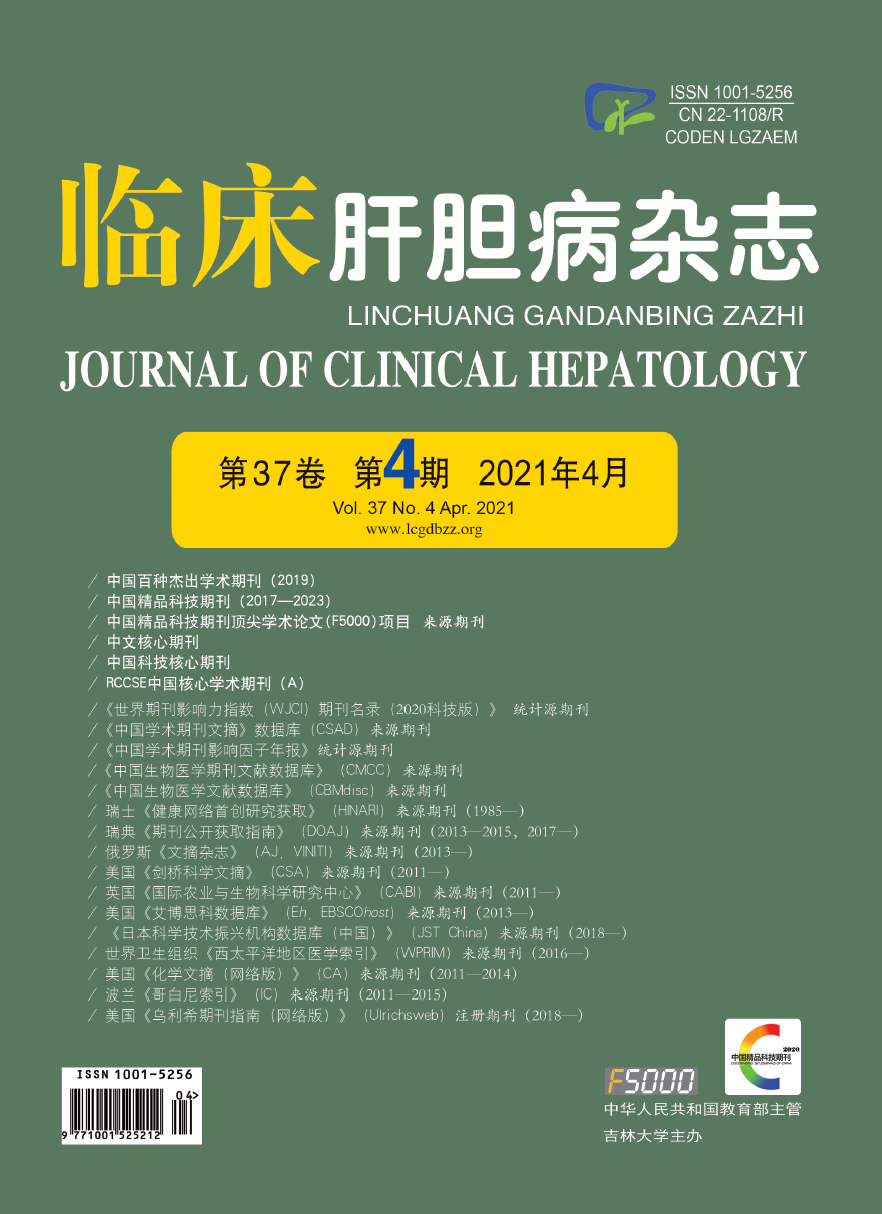| [1] |
WANG WJ, YU CH. Improvement in liver function in patients with malignant obstructive jaundice after endoscopic biliary metallic stent drainage[J]. J Clin Hepatol, 2015, 31(8): 1295-1298. DOI: 10.3969/j.issn.1001-5256.2015.08.027. |
| [2] |
ZHANG K, ZHANG MF, REN JZ, et al. Efficacy of percutaneous intraductal radiofrequency ablation combined with biliary stenting in treatment of malignant biliary obstruction[J]. J Clin Hepatol, 2015, 31(5): 737-740. DOI: 10.3969/j.issn.1001-5256.2015.05.025. |
| [3] |
LEE SH, PARK JK, YOON WJ, et al. Optimal biliary drainage for inoperable Klatskin's tumor based on Bismuth type[J]. World J Gastroenterol, 2007, 13(29): 3948-3955. DOI: 10.3748/wjg.v13.i29.3948. |
| [4] |
CHEN BY, PANG LY. Implantation of biliary metallic stent for malignant obstructive jaundice: Technical comparison study between via ERCP route and via PTCD route[J]. J Intervent Radiol, 2016, 25(10): 880-884. DOI: 10.3969/j.issn.1008-794X.2016.10.011. |
| [5] |
PAN HW, WANG C, ZHANG Y. Risk factors of post-operative pancreatitis and hyperamylosis after endoscopic retrograde cholangiopancreatography[J]. China J Endosc, 2018, 24(7): 26-32. DOI: 10.3969/j.issn.1007-1989.2018.07.005. |
| [6] |
SUGAWARA S, ARAI Y, SONE M, et al. Frequency, severity, and risk factors for acute pancreatitis after percutaneous transhepatic biliary stent placement across the papilla of vater[J]. Cardiovasc Intervent Radiol, 2017, 40(12): 1904-1910. DOI: 10.1007/s00270-017-1730-1. |
| [7] |
KIM ET, GWON DI, KIM JW, et al. Acute pancreatitis after percutaneous insertion of metallic biliary stents in patients with unresectable pancreatic cancer[J]. Clin Radiol, 2020, 75(1): 57-63. DOI: 10.1016/j.crad.2019.07.014. |
| [8] |
BANKS PA, BOLLEN TL, DERVENIS C, et al. Classification of acute pancreatitis-2012: Revision of the Atlanta classification and definitions by international consensus[J]. Gut, 2013, 62(1): 102-111. DOI: 10.1136/gutjnl-2012-302779. |
| [9] |
QIAN Z, LIU HC, PANG Q, et al. The clinical efficacy and prognostic factors of percutaneous biliary stent implantation combined with 125Ⅰ seed intracavitary irradiation in the treatment of cholangiocarcinoma[J]. Chin J Radiol, 2018, 52(8): 640-643. DOI: 10.3760/cma.j.issn.1005-1201.2018.08.014. |
| [10] |
|
| [11] |
LIU R, HUANG K, CHEN WW, et al. Clinical effect of biliary stenting combined with percutaneous transhepatic cholangial drainage in treatment of different types of malignant obstructive jaundice[J]. J Clin Hepatol, 2019, 35(1): 131-137. DOI: 10.3969/j.issn.1001-5256.2019.01.025. |
| [12] |
ZHAO XQ, DONG JH, JIANG K, et al. Comparison of percutaneous transhepatic biliary drainage and endoscopic biliary drainage in the management of malignant biliary tract obstruction: A meta-analysis[J]. Dig Endosc, 2015, 27(1): 137-145. DOI: 10.1111/den.12320. |
| [13] |
KAWAKUBO K, ISAYAMA H, NAKAI Y, et al. Risk factors for pancreatitis following transpapillary self-expandable metal stent placement[J]. Surg Endosc, 2012, 26(3): 771-776. DOI: 10.1007/s00464-011-1950-4. |
| [14] |
TELFORD JJ, CARR-LOCKE DL, BARON TH, et al. A randomized trial comparing uncovered and partially covered self-expandable metal stents in the palliation of distal malignant biliary obstruction[J]. Gastrointest Endosc, 2010, 72(5): 907-914. DOI: 10.1016/j.gie.2010.08.021. |
| [15] |
KAHALEH M, TOKAR J, CONAWAY MR, et al. Efficacy and complications of covered Wallstents in malignant distal biliary obstruction[J]. Gastrointest Endosc, 2005, 61(4): 528-533. DOI: 10.1016/s0016-5107(04)02593-3. |
| [16] |
KULLMAN E, FROZANPOR F, SÖDERLUND C, et al. Covered versus uncovered self-expandable nitinol stents in the palliative treatment of malignant distal biliary obstruction: Results from a randomized, multicenter study[J]. Gastrointest Endosc, 2010, 72(5): 915-923. DOI: 10.1016/j.gie.2010.07.036. |
| [17] |
COTÉ GA, KUMAR N, ANSSTAS M, et al. Risk of post-ERCP pancreatitis with placement of self-expandable metallic stents[J]. Gastrointest Endosc, 2010, 72(4): 748-754. DOI: 10.1016/j.gie.2010.05.023. |
| [18] |
ARTIFON EL, SAKAI P, ISHIOKA S, et al. Endoscopic sphincterotomy before deployment of covered metal stent is associated with greater complication rate: A prospective randomized control trial[J]. J Clin Gastroenterol, 2008, 42(7): 815-819. DOI: 10.1097/MCG.0b013e31803dcd8a. |
| [19] |
YOON WJ, LEE JK, LEE KH, et al. A comparison of covered and uncovered Wallstents for the management of distal malignant biliary obstruction[J]. Gastrointest Endosc, 2006, 63(7): 996-1000. DOI: 10.1016/j.gie.2005.11.054. |
| [20] |
JO JH, PARK BH. Suprapapillary versus transpapillary stent placement for malignant biliary obstruction: Which is better?[J]. J Vasc Interv Radiol, 2015, 26(4): 573-582. DOI: 10.1016/j.jvir.2014.11.043. |
| [21] |
TARNASKY PR, CUNNINGHAM JT, HAWES RH, et al. Transpapillary stenting of proximal biliary strictures: Does biliary sphincterotomy reduce the risk of postprocedure pancreatitis?[J]. Gastrointest Endosc, 1997, 45(1): 46-51. DOI: 10.1016/s0016-5107(97)70301-8. |
| [22] |
COSGROVE N, SIDDIQUI AA, ADLER DG, et al. A comparison of bilateral side-by-side metal stents deployed above and across the sphincter of oddi in the management of malignant hilar biliary obstruction[J]. J Clin Gastroenterol, 2017, 51(6): 528-533. DOI: 10.1097/MCG.0000000000000584. |
| [23] |
ZHANG JX, ZU QQ, LIU S, et al. Differences in efficacy of uncovered self-expandable metal stent in relation to placement in the management of malignant distal biliary obstruction[J]. Saudi J Gastroenterol, 2018, 24(2): 82-86. DOI: 10.4103/sjg.SJG_326_17. |








 DownLoad:
DownLoad: